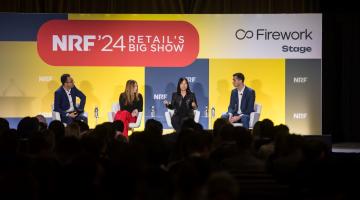
Suresh Krishna, CEO and president of Northern Tool + Equipment, speaks with NRF Vice President of Supply Chain and Customs Policy Jon Gold at the NRF Supply Chain 360 Summit during NRF 2024: Retail's Big Show.
Today’s consumers expect plenty of options — buying online, buying in store, having items delivered the same day or in a week, picking up orders curbside. But what if small and mid-size retailers had the same flexibility? What does it look like when a supply chain team has options?
“Covid was a wakeup call for things that were bubbling and accelerated things that were in mind for us,” including things like buy online, pick up in store, Suresh Krishna, CEO and president of Northern Tool + Equipment, said during a keynote at the NRF Supply Chain 360 Summit, which ran concurrently with NRF 2024: Retail’s Big Show in New York City.
Browse photos, blog posts, videos and more from NRF 2024: Retail’s Big Show.
The optionality framework
Krishna, who became CEO and president of the national retailer in April 2020, said COVID-19 became an opportunity to rethink the supply chain. “For us, resiliency was top of mind, and so our supply chain team came up with a framework called ‘optionality,’” he told NRF Vice President of Supply Chain and Customs Policy Jon Gold.
The optionality framework at Northern Tool + Equipment is rooted in supporting two overarching goals; the first is customer service. “Everything we have done in our supply chain over the last three years or so has been done around enhancing service and enhancing speed,” Krishna said.
For a mid-sized, omnichannel retailer selling over 100,000 items ranging from safety gloves to trailer-sized pressure washers, enhancing speed when the supply chain was already strained was a challenge. Especially when approximately 35% of those items were imported from outside the United States, and 90% of those imports came from China.
For Northern Tool + Equipment, that meant changing the flow of shipping containers from the Port of Los Angeles — which had 20-40 days of containers and ships stuck outside the port — to the Port of Charleston on the East Coast.
“Our supply chain [team] had the foresight fairly early to say we need to have this optionality framework,” Krishna said. The company still uses both ports, toggling between Los Angeles and Charleston based on shipping traffic and inventory needs.
Moving away from China
Northern Tool + Equipment also began looking at other sourcing options to supply its 140 retail stores and robust ecommerce business. “Our goal was to diversify and provide our supply chain team the optionality to source from multiple locations,” Krishna explained, so the team set up offices in India, Vietnam Mexico and Taiwan to source from other markets in a cost competitive way.
Today, less than 50% of Northern Tool + Equipment imported products are coming from China. In addition, the company recently announced that it was closing a factory in China and moving production to Mexico to further bolster and support its two U.S. factories. “We’re not saying we’re not going to be in China,” Krishna said. “But we’re taking this opportunity to source from both.”
The supply chain team also needed more options for fulfilling ecommerce orders, which make up 35% of the company’s revenues. Three years ago, all ecommerce orders were directed to the company’s primary warehouse outside of Charlotte, N.C., even though the company also had warehouses in Minneapolis and Arlington, Texas.
Northern Tool + Equipment started using data and technology to spread out inventory and service fulfillment among its warehouses, allowing them to decide where an order should be directed to. It also recently opened a fourth warehouse in Las Vegas to serve customer orders in the western part of the country.
Shifting from bricks-and-mortar to bricks-and-ship
Increasingly, some of those online orders are being fulfilled at one of the company’s 22,000-square-foot stores.
Northern Tool + Equipment was an early adopter of ship-from-store, which required putting the right infrastructure in place, including technology and order management systems, employee training and setting up the stores themselves as shipping locations. All of it was a big change, Krishna said, but ship-from-store has expanded the company’s geographic reach and cut days for delivery from five to seven days to two or three days.
In addition, 99% of those orders are now shipped same-day compared with only 17% three years ago. “Everything we’ve done touches the 3,000-plus associates we have in the organization,” Krishna said. “Everything we did to transform to 99% ship in a day was done by our employees.”


